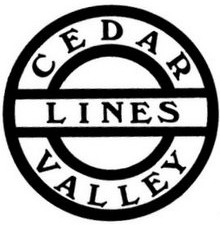Operating The Cedar Vally Short Lines
Rationale`:The Cedar Valley is set in the late 1950's in West Virginia and is based on Tony Koester's famous Allegheny Midland. It is a Class 1 railroad operating between the Chesapeake & Ohio to the South and the Nickel Plate to the North. It also interchanges with the Norfolk & Western and the Western Maryland so apart from CV equipment that of the other railroads will be seen.
Destinations to the North and South respectively are represented by the 9 North Staging tracks underneath the window and the 9 South Staging tracks under the coal branch adjoining the garage.
Operations:
The main business of the CV is as a bridge line transporting the connecting railroad's freight and passengers from north to south and vice versa, transporting coal extracted from the local area either north to the Great Lakes (Lake Coal) or south to tidewater (Tide Coal). Most trains therefore operate from staging to staging, representing connections with the other railroads. There is also substantial traffic generated by the coalmines of the area (Silver Springs & Antonia No.1) as well as local freight and passenger trains that require transport and switching of freight and passenger rolling stock.
Timetable and Train Orders:
Trains operate in accordance with the timetable and amendments thereto (train orders) issued by the Dispatcher.
Meets and Passes:
Meets and passes between trains require that first class (passenger and express freight) trains have priority over second (normal freight) and third (coal/empty) class trains.
Classes of Trains:
First: Passenger & Express Freight
Second: Normal freight
Third: Coal loads and empties
Terminals:
Responsibility for operations within yard limits at Cedar Valley and South Fork/Middleton lie specifically with the respective yardmasters who have the authority to accept/ dispatch trains, operate the turnouts, block and otherwise make up/break up trains. Train crews must request approval from yardmasters before entering the final single line trackage before the relevant terminals.
Turnouts:
All turnouts except where remotely operated are by CV developed slide switch throws. These switches should be gripped low down between thumb and forefinger to avoid breaking off the targets, the targets should be turned to show red when set to the diverging route and the turnouts must be returned to the Normal (Through) route after exiting. Note that the switch must be pushed/pulled to the limit of its travel to ensure correct electrical routing is achieved.
Control:
CVP Easy DCC is used. All throttles must be returned to the 99 setting when not in use and stored in the fascia-mounted holders. Any radio throttles should be switched off when they are not in use.
Electrical Security:
Any locomotive or car that moves beyond the foul point approaching turnouts set for the other direction will cause a short circuit, so shutting down the whole layout. Foul points are indicated by a red marker, ground signal or a yellow painted tie.
Train Numbering:
200 series: operate from staging to the adjoining terminal by yardmasters who add/drop cuts; assign crews to operate to the other terminal where they detrain. The Receiving yardmaster or Hostler adds/drops cuts and runs the train into staging.
300 series: run from staging by yardmaster s as before, then operated by local crews to terminate within the modelled area, switching towns as required by switch lists/bills of lading.
400 series: originate and terminate within the modelled area
500 series: branch line and trains to/from WM and B&O interchanges.
North Bound trains are odd numbered
South bound trains are even numbered
Car Cards:
Are no longer used on the railroad. Rather all trains will have instructions as to delivery or collection of cars included it the Train Orders.
Depots:
Heading north from Richmond, Virginia (9 track South Staging) & adjoining the garage we have:
Cedar Valley: terminal. Has connection through Idden (under Silver Spring mine) to Connellsville for re-staging. Yardmaster in charge and adjoins South Staging (Richmond), has minimal engine servicing & turning facilities, ice house, freight house, main line & passing tracks, arrival & departure tracks, 3 classification tracks and branches to Valley Center and Boyd Gap
South is to the left, North is to the right.
Grant is the next location north with a coal dump track and is adjacent to the southern Western Maryland staging track and Interchange.
Craig is reached after transiting Coal Creek tunnel. It has one industry spot and may hold a helper engine.
Silver Spring Junction is the next depot with main line, secondary (or passing) track, depot track, 3 industry spots and is the junction for the Silver Spring branch.
South is to the right, North is to the left.
After traversing the steel trestle bridge over Coal Creek Altapass is next station with an escape or pocket track for helpers returning from Summit. Provision also exists here to reverse a train by using the two designated turnouts.
North is to the Left, South to the Right
Summit with its long passing siding. is the highest point on the CV and is reached through the wall. Trains transiting Summit may be seen on the B&W monitor on the upper fascia over South Cedar Valley.
Next is Glady then another tunnel takes us to
South Fork, the south end of Middleton. Joint yardmaster with Middleton, mallet servicing and storage, The Antonia No. 1 mine branch diverts here.
Middleton, terminal, joint yardmaster with South Fork, 3 classification tracks and shares 17 industry spots with South Fork.
Adjoins Connellsville (North Staging) with a continuous connection to Cedar Valley via Idden (under coal branch) that is not normally used for normal operations but allows restaging of trains.
February 2015.
